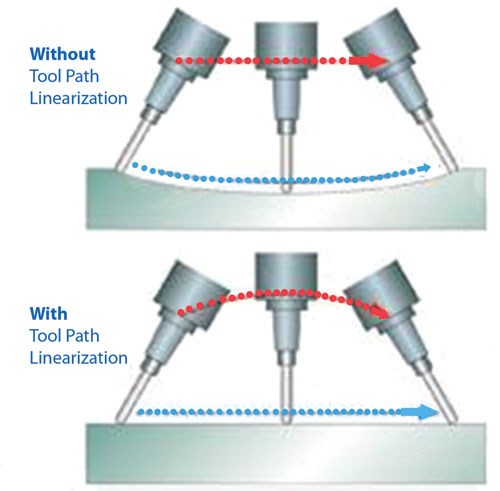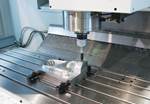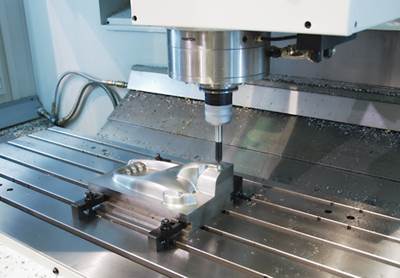Making the Move to a 5-Axis VMC
A look at some technology advancements that should encourage mold manufacturers to think again about integrating 5-axis machining into their operations.
While the majority of mold shops still use 3-axis VMCs, the advancements in machine tools, speeds and feeds, toolpaths, tooling and control features during the last few years make this the perfect time to reconsider integrating a 5-axis machining center into your mold manufaturing facility. Simultaneous 5-axis machining is particularly pertinent if your shop does deep cavity molds or tall core molds.
If you are producing deep cavity molds on a 3-axis VMC, you have to use long, skinny tools. To prevent tool breakage and minimize chatter, you have to slow down the feedrates. With simultaneous 5-axis machining, the additional axes allow you to use shorter, stouter tools.
The ability to use shorter tooling with 5-axis machining reduces the deflection of the tool, increases surface finish quality, significantly reduces the need to polish the mold, and in many cases, eliminates the need for EDM operations. With shorter tools, you can push faster with increased feedrates and take heavier cuts.
When you start researching 5-axis machines, there are a few important items to consider as you narrow down your choices.
1. Machine Configuration
For simplification, we will cover two of the main types of dedicated 5-axis machining centers. One type is called a B/C 5-axis machine configuration and the other is an A/C 5-axis machining center, which denotes the additional two axes you gain in addition to X,Y and Z.
BC 5-axis machining centers (swivel head with rotary table design)
The B/C machines use a rotary table and a swivel or tilting head that allows the tool to tilt and rotate. With the B/C type of 5-axis machining center, it is extremely important to make sure the table (C-axis) has unlimited angular movement.
For example, if you are machining down a steep wall and going around the part, the table needs to rotate in a continuous motion. If the C-axis only has +360 / -360 degrees of motion, it will literally need to unwind at regular intervals to machine the part. You can imagine how this unwinding slows down the process.
A/C 5-axis machining center (tilt rotary table design)
The A/C type of 5-axis machining center employs the use of a tilt rotary table. If your molds require deep undercuts, this type of machine is preferred over the B/C. However, the B/C 5-axis design is better for heavy molds because the trunnion style (A/B machine) has to tilt the workpiece.
2. Repeatability and Accuracy
Probably the best tip in reference to repeatability and accuracy specifications is to ask for a customer reference as you get further along in the buying process or talk to an applications engineer. Repeatability specifications from a machine tool builder won’t replicate your exact conditions.
While measurement processes are stringent and well defined whether a builder uses the 10 Pass VDI-3441 method or JIS 6330, these specifications don’t take into account cutting and thermal loads. Accuracy measurements are even more important with 5-axis because you are stacking up the variations with two additional axes. While the accuracy specifications provided are accurate given the process employed, customers who have similar applications often provide the most relevant information.
3. Control Features
Even though you use a CAM system, don’t overlook the multiple advancements in control technology that improve surface finish, increase productivity and accelerate machining time. Your CAM system is important, but how the machine tool’s control handles the part program matters. The most important specifications are RAM and processing speed. In addition to the technical specifications, there are numerous advancements in control technology that enhance the NC part program and machining process.
Tool center point management (TCPM):TCPM eliminates the need to account for the 5-axis machining center’s center lines of rotation. Instead, you simply program from part zero. This feature eliminates the need to go back to the CAM system and recalculate the center lines of rotation because the 5-axis tool motion is programmed in the workpiece coordinate system, independent of setup location in the machine.
Automatic safe repositioning (ASR): An addition of one G-Code tells the machine to retract along the vector and overrides the out of limits protocol. No stoppage. No error message. The software is smart enough to retract, move to Z0 along the X-limit, reorient the tool, move to retract plane, move above the plunge point and plunge to the target along the tool vector.
Toolpath linearization: This eliminates gouging of the workpiece and minimizes the loops (the line segments in the form of XYZBC or AC moves that a CAM system uses), which improves surface finish. Additionally, this feature significantly reduces the size of NC programs (see Figure 1).
Unlimited work offsets: A feature called NC/conversational merge allows you to call up an NC program, and apply pattern operations or scaling to your G-code program, which means you have an unlimited number of work offsets.
3-D tool geometry compensation: This eliminates the need to repost the part program after adjusting the tool diameter for wear.
Summary
Due to advancements in control technology, 5-axis machining centers, CAD/CAM software, pricing and tooling, the time is right to consider an investment in a 5-axis machining centers for your mold shop. Educating yourself about the basics of 5-axis machining will help you identify the right questions to ask during the purchasing process.
Related Content
It Starts With the Part: A Plastic Part Checklist Ensures Good Mold Design
All successful mold build projects start with examining the part to be molded to ensure it is moldable and will meet the customers' production objectives.
Read MoreThe Benefits of Hand Scraping
Accuracy and flatness are two benefits of hand scraping that help improve machine loop stiffness, workpiece surface finish and component geometry.
Read MoreSolving Mold Alignment Problems with the Right Alignment Lock
Correct alignment lock selection can reduce maintenance costs and molding downtime, as well as increase part quality over the mold’s entire life.
Read MoreMachining Center Spindles: What You Need to Know
Why and how to research spindle technology before purchasing a machining center.
Read MoreRead Next
How to Get the Most Out of Your Control
If the spindle is the heart of the machining center, the control is the brain. This article will help you explore whether it’s time to expand your brain and find new efficiencies to increase profitability.
Read MoreAre You a Moldmaker Considering 3D Printing? Consider the 3D Printing Workshop at NPE2024
Presentations will cover 3D printing for mold tooling, material innovation, product development, bridge production and full-scale, high-volume additive manufacturing.
Read MoreHow to Use Strategic Planning Tools, Data to Manage the Human Side of Business
Q&A with Marion Wells, MMT EAB member and founder of Human Asset Management.
Read More























